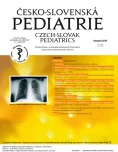Ten years of neonatal screening of cystic fibrosis in Slovakia
Authors:
S. Dluholucký 1,2; M. Knapková 1; A. Revťáková 1
Authors‘ workplace:
Skríningové centrum novorodencov SR, Detská fakultná nemocnica s poliklinikou, Banská Bystrica, Slovensko
1; Slovenská zdravotnícka univerzita v Bratislave, Fakulta zdravotnictva SZÚ, Banská Bystrica, Slovensko
2
Published in:
Čes-slov Pediat 2019; 74 (7): 387-391.
Category:
Overview
The authors present 10 years of experience with neonatal screening of cystic fibrosis (NSCF) in Slovakia (2009–2018), using the new neo-IRT ILMA kit.
Method: During the kit test (2007), up to 31% of high IRT children were Roma. For the risk of a disproportionately high percentage of false positivity, this required a higher cut-off limit for Roma neonates in the form of a prospective study comparing IRT1 and IRT2 levels in majority (M) and Roma (R) ethnicity. After their introduction into practice, the results of 10 years of NSCF are evaluated.
Results: In a group of 8742 newborn M groups and 1500 newborn infants in the R group, there were highly statistically significant differences in IRT levels (p<0.001) and IRT1 cut-off limits were determined = 72 ng/ml, IRT2 = 60 ng/ml for M group and IRT1 = 84 ng/ml, IRT2 = 72 ng/ml for R group. In 10 years of NSCF, 558938 newborns (85.2% M and 14.8% R groups) were examined, the IRT (recall rate) percentage was higher in the R group despite the higher cut-off limit (0.48% vs. 0.28%). A total of 75 CF cases, all in the M group, were detected and confirmed, and none of the cases were found in the Roma newborn. The overall incidence of CF in the pool was 1:7452, calculated on an M population of 1:5110 live births.
Conclusions: The ethnically performed NSCF confirmed the need for different IRT cut-off limits due to its higher values in the Roma ethnic group, as well as virtually no CF in the 10-year Roma population in Slovakia. This approach may reduce the excessively high recall and thus the stress of the ethnic family with higher IRTs in ethnically mixed populations, and shift the knowledge of the real incidence of CF under given conditions.
Keywords:
Cystic fibrosis – Roma ethnicity – ethnic neonatal screening
Sources
1. Loeber JG, Burgard P, Cornel MC, et al. Newborn screening programmes in Europe: arguments and efforts regarding harmonization. Part 1. J Inherit Metab Dis 2012; May 3.
2. Burgard P, Rupp K, Linder M, et al. Newborn screening programmes in Europe, arguments and efforts regarding harmonization. Part 2. J Inherit Metab Dis 2012; April 28.
3. Dluholucký S, Knapková M. Newborn screening in Slovakia – from 1985 till today. Acta Facul Pharm Univ Commeniannae 2013; Suppl VIII: 32–37.
4. Watson MS, Mann MY, Lloyd-Puryear MA, et al. Newborn screening: Toward a uniform screening panel and system – executive summary. Pediatrics 2006; 117: S296–S307.
5. Dluholucký S, Knapková M. The first results of extended newborn screening in Slovakia – differences between the majority and the Roma ethnic group. Internat J Neonatal Screen (IJNS) 2017; 3 (3): 25–30.
6. Vávrová V, Zemková D, Skalická V, Votava F. Problémy v diagnostice cystické fibrózy – potřeba novorozeneckého screeningu. Čes-slov Pediat 2006; 61 (12): 703–709.
7. Wilcken B, Gaskin K. More evidence for favour newborn screening for cystic fibrosis. Comment. Lancet 2007; 369: 1146–1147.
8. Ditterová L, Vávrová V, Skalická V, et al. Novorozenecký screening cystické fibrózy (souborný referát). Čes-slov Pediat 2006; 60 (6): 373–378.
9. Loeber JG. Neonatal screening in Europe: the situation in 2004. J Inherit Metab Dis, doi 10: 2007/s.10545-007-0644-5.
10. Holubová A, Balaščáková M, Skalická V, et al. Novorozenecký screening cystické fibrózy v České republice: závěry pilotní studie. Čes-slov Pediat 2007; 62 (4): 187–195.
11. Balaščáková M, Piskáčková T, Holubová A, et al. Současné metodické postupy a přehled preimplantační, prenatální a postnatální DNS diagnostiky cystické fibrózy v České republice. Čes-slov Pediat 2008; 53 (2): 62–75.
12. Roussey M, Munck A, Dhondt J-L, et al. Four years experience of the French nationwide cystic fibrosis (CF) newborn screening (NBS) strategy and results on more than 2 million births. Database Eurocordis, code 122, IP: 90.32.238.341.
13. Efron B, Tibshirani R. Bootstrap methods for standard errors: Confidence intervals and other measures of statistical accuracy. Statistical Science 1986; 1: 54–77.
14. Castellani C, Massie J. Emerging issues in cystic fibrosis newborn screening. Curr Opin Pulm Med 2010; 16: 584–590.
15. Cornel M, Rigter T, Weinreich S, et al. Newborn screening in Europe. Expert opinion document. Assessed 24 Febr. 2012.https://www.iss.it/enmr/prog/cont.php?id=1621&lang=1&tipo=64.
15. Raffle A, Gray M. Screening. Evidence and Practice. Oxford Univ Press, 2007.
16. Simps E, Mugford M, Clark A, et al. Economic implications of newborn screening for cystic fibrosis: a cost of illness retrospective cohort study. Lancet 2007; 369: 1187–1195.
17. Giusti R, Comber P, Gernmana J, et al. Elevated IRT levels in African--American infants: implications for newborn screening in an ethnically diverse population. Pediat Pulmonol 2008; 43 (7): 638–641.
18. Cheillan D, Vercherat M, Chevaier-Porst F, et al. False-positive results in neonatal screening for cystic fibrosis based on three-stage protocol (IRT/DNA/IRT). Should we adjust IRT cut-off to ethnic origin? J Inherit Metab Dis 2005; 28 (6): 813–818.
19. Endreffy E, Németh K, Fekete G, et al. Molecular genetic diagnostic difficulties in two Hungarian gypsy samples with cystic fibrosis. IJHG 2002; 2 (1): 41–44.
Labels
Neonatology Paediatrics General practitioner for children and adolescentsArticle was published in
Czech-Slovak Pediatrics

2019 Issue 7
Most read in this issue
- Cystic fibrosis newborn screening and CFSPID diagnostics
- Viscoelastic method rotational thromboelastometry (ROTEM)
- Historie cystické fibrózy u nás – editorial
- Ten years of neonatal screening of cystic fibrosis in Slovakia
